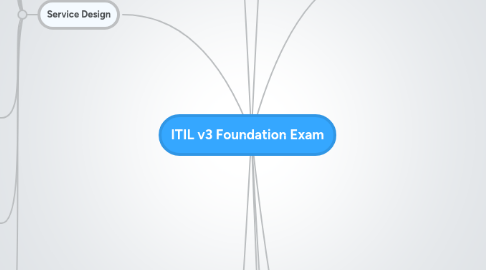
1. Service Strategy
1.1. Service Strategy
1.1.1. Understand the Market
1.1.2. Develop the offerings
1.1.3. Develop strategic assets
1.1.4. Prepare for execution
1.2. Service Portfolio Management
1.3. Demand Management
1.3.1. User Profiles
1.3.2. Pattern of Business Activity
1.4. Financial Management
1.4.1. Accounting
1.4.2. Budgeting
1.4.3. Charging
1.5. Concepts
1.5.1. Service Provider
1.5.2. Business Case
1.5.3. ROI
1.5.4. Value
1.5.4.1. Utility
1.5.4.1.1. Fit for purpose
1.5.4.2. Warranty
1.5.4.2.1. Fit for use
1.5.5. Service Assets
1.5.5.1. Resources
1.5.5.2. Capabilities
1.5.6. Service Portfolio
1.5.6.1. Service Pipeline
1.5.6.2. Service Catalog
1.5.6.3. Retired Service
1.5.7. Service Belt
1.5.7.1. Service Asset
1.5.7.1.1. Increase potential value of CA
1.5.7.1.2. Sustain and improve service levels delivered
1.5.7.2. Customer Asset
1.5.7.2.1. Credit or Compensation
1.5.7.2.2. Utilize the potential of SA
2. Service Design
2.1. Service Catalog Management
2.1.1. Feature
2.1.2. Guidelines
2.1.3. Means of access
2.1.4. Pricing
2.1.5. Key Contact
2.1.6. SLA
2.2. Service Level Management
2.2.1. SLA
2.2.2. OLA
2.3. Availability Management
2.3.1. Service Level Targets
2.4. Capacity Management
2.4.1. Business Capacity Management
2.4.2. Service Capacity Management
2.4.3. Component Capacity Management
2.5. Service Continuity Management
2.5.1. Business Impact Analysis
2.5.2. Management of Risk
2.5.3. IT Service Continuity Plan
2.5.4. Business Continuity Plan
2.6. IT Security Management
2.6.1. IT Security Policy
2.6.2. Confidentiality
2.6.3. Integrity
2.6.4. Availability
2.6.5. Authenticity
2.6.6. Non-Repudiation
2.7. Supplier Management
2.7.1. 3rd Party Suppliers
2.8. Concepts
2.8.1. 4 P's of Service Design
2.8.1.1. People
2.8.1.2. Processes
2.8.1.3. Products
2.8.1.4. Partners
2.8.2. 5 Aspects of Service Design
2.8.2.1. New or Changed
2.8.2.2. Processes required
2.8.2.3. Systems and tools
2.8.2.4. Technology Architecture
2.8.2.5. Measurement systems and metrics
3. Service Transition
3.1. Change Management
3.1.1. Configuration Items
3.1.2. Major Activities
3.1.2.1. Recording
3.1.2.2. Review
3.1.2.3. Assessment and Evaluation
3.1.2.4. Authorization
3.1.2.5. Planning
3.1.2.6. Implementation Coordination
3.1.2.7. Review and Closure
3.2. Service Asset and Configuration Management
3.2.1. Planning
3.2.2. Identification
3.2.3. Control
3.2.4. Status Accounting
3.2.5. Verification and Audit
3.3. Concepts
3.3.1. Service V-Model
3.3.1.1. Review
3.3.1.2. Acceptance
3.3.1.3. Operational
3.3.1.4. Release Test
3.3.1.5. Release Design/Plan
3.3.2. Change
3.3.2.1. Normal
3.3.2.2. Standard
3.3.2.3. Emergency
3.3.3. Request for Change
3.3.4. Change Authority
3.3.5. Change Advisory Board
3.3.6. Emergency Change Advisory Board
3.3.7. Change Model
3.3.8. Release
3.3.9. Release Unit
3.3.10. Baseline
3.3.11. Configuration Management System
3.3.12. Configuration Item
3.4. Release and Deployment Management
4. Service Operation
4.1. Incident Management
4.1.1. Detection
4.1.2. Logging
4.1.3. Classification
4.1.4. Prioritization
4.1.4.1. Impact
4.1.4.2. Urgency
4.1.5. Investigation and Initial Diagnosis
4.1.6. Escalation
4.1.7. Resolution and Recovery
4.1.8. Closure
4.2. Problem Management
4.2.1. Reactive
4.2.2. Proactive
4.2.3. Root Cause
4.2.4. Work Around
4.2.5. Known Error Database
4.3. Event Management
4.3.1. Informational
4.3.2. Warning
4.3.3. Exception
4.4. Service Request Fufillment
4.4.1. Standard Changes
4.5. Access Management
4.5.1. Uses Information Security Policy
4.6. Concepts
4.6.1. Balance
4.6.2. Communication
4.6.3. Incident
4.6.4. Problem
4.6.5. Error
4.6.6. Known Error
4.6.7. Event
5. Continual Service Improvement
5.1. The 7 Steps Improvement Process
5.1.1. Decide what should be measured
5.1.2. Decide what can be measured
5.1.3. Gather the data
5.1.4. Process the data
5.1.5. Analyze the data
5.1.6. Plan and Implement Changes
5.1.7. Investigate and Diagnose
5.2. Concepts
5.2.1. Role of Measurement
5.2.1.1. Justify
5.2.1.2. Direct
5.2.1.3. Intervene
5.2.1.4. Validate
5.2.2. Objectives
5.2.3. CSFs
5.2.4. KPIs
5.2.5. Metrics
5.2.6. Measurements
5.2.7. Deming Cycle
5.2.7.1. Plan
5.2.7.2. Do
5.2.7.3. Check
5.2.7.4. Act
5.2.8. CSI Model
5.2.8.1. What is the vision?
5.2.8.2. Where are we now?
5.2.8.3. Where do we want to be?
5.2.8.4. How do we get there?
5.2.8.5. Disd we get there?
5.2.8.6. How do we maintain momentum?
5.2.9. Service Improvement Plan
6. Technology and Architecture
6.1. Information Systems
6.1.1. Service Knowledge Management System (SKMS)
6.1.2. Service Portfolio/Catalog
6.1.3. Availability Management Information System (AMIS)
6.1.4. Configuration Management System (CMS)
6.1.5. Configuration Management Database (CMDB)
6.1.6. Capacity Database (CDB)
6.1.7. Capacity Management Information System (CMIS)
6.1.8. Known Error Database (KEDB)
6.1.9. Security Management Information System (SMIS)
7. ITIL Core Concepts
7.1. ITIL as a Good Practice Framework
7.1.1. Standards
7.1.2. Public frameworks
7.1.3. Academic research
7.1.4. Proprietary knowledge
7.2. The Service Lifecycle
7.3. Processes
7.3.1. Characteristics
7.3.1.1. They are triggered by specific events
7.3.1.2. They deliver results to a specific customer or stakeholder
7.3.1.3. They are measurable
7.3.1.4. They transform inputs into outputs
7.3.2. Process Control
7.3.2.1. Policies
7.3.3. The Process itself
7.3.4. Process Enablers
7.3.4.1. Capabilities
7.4. Functions
7.5. Roles
7.5.1. Service Owner
7.5.2. Process Owner
7.5.3. Service Manager
7.5.4. Product Manager
8. ITIL Functions
8.1. Service Desk
8.1.1. Local
8.1.2. Centralized
8.1.3. Virtual
8.1.4. Follow-the-Sun
8.2. Technical Management
8.3. Application Management
8.4. IT Operations Management
8.4.1. Operations Control
8.4.2. Facilities Management
